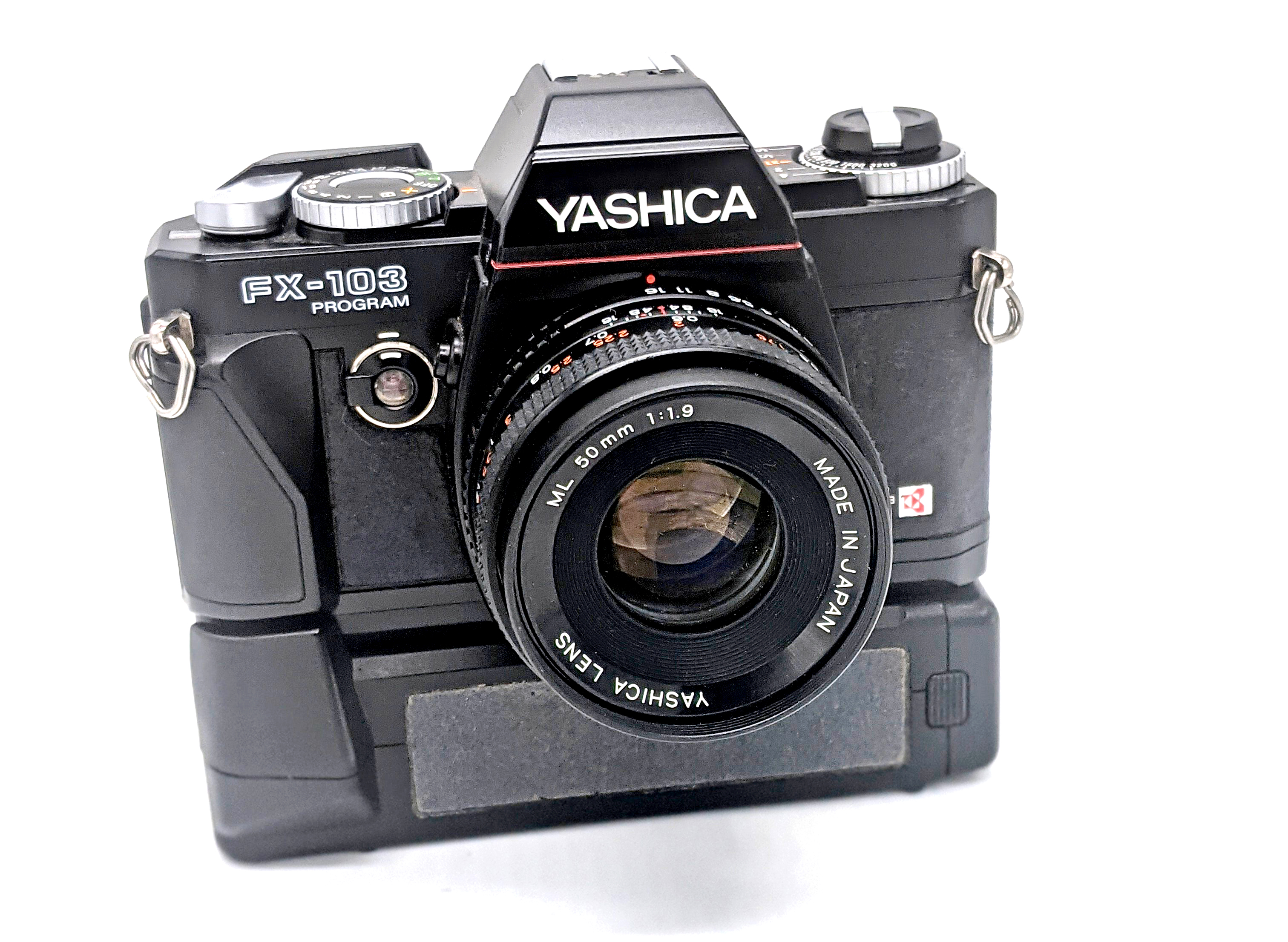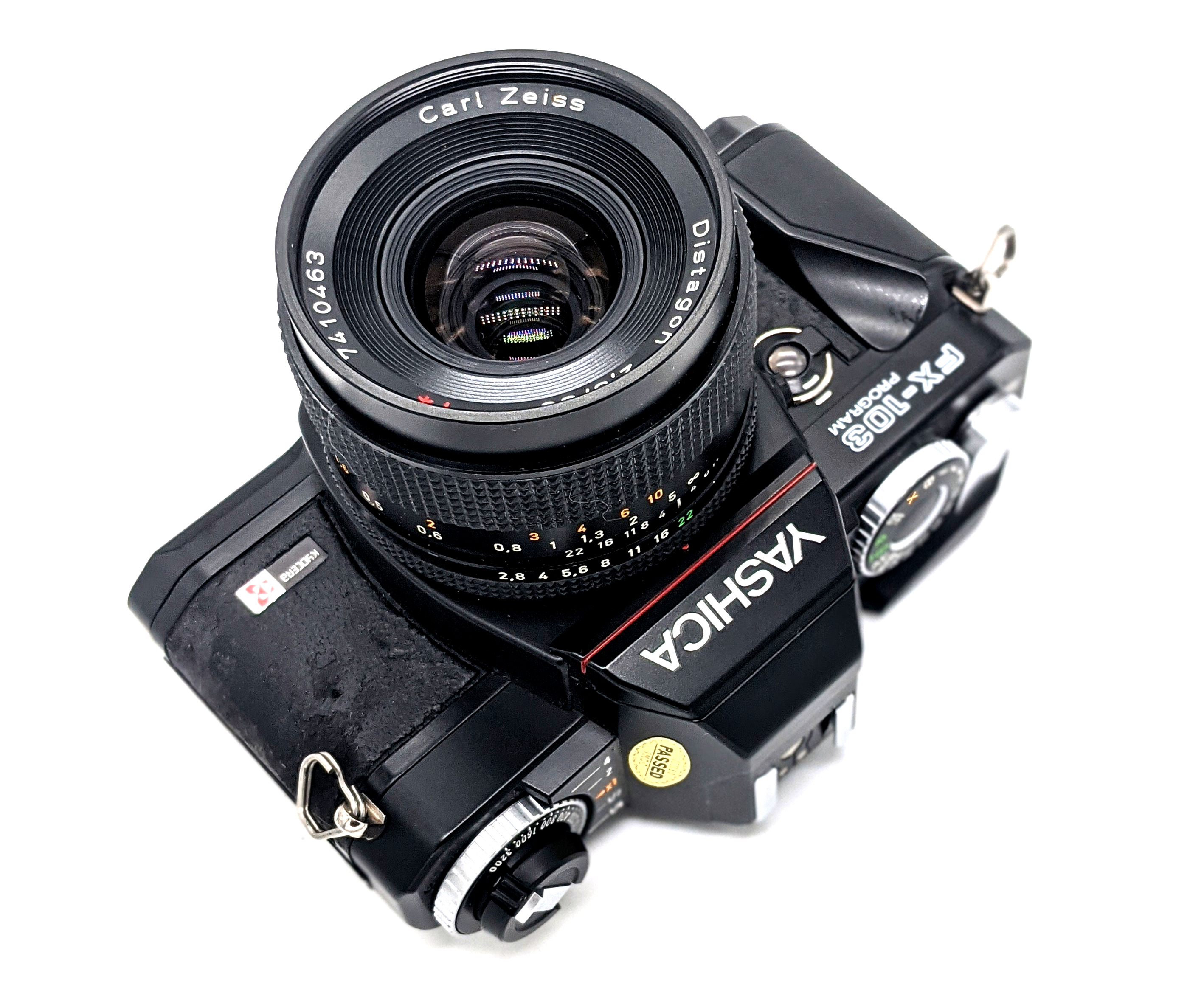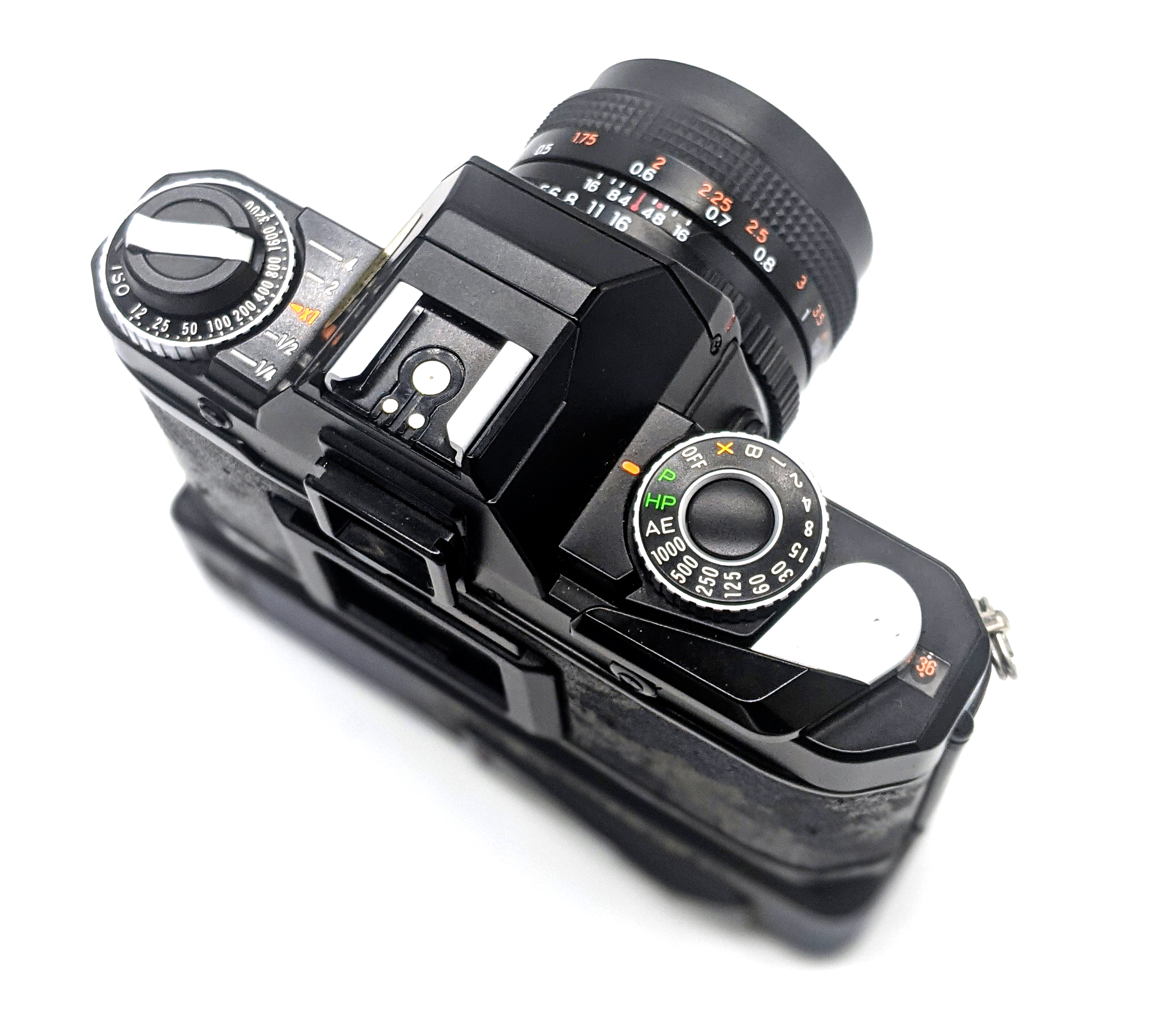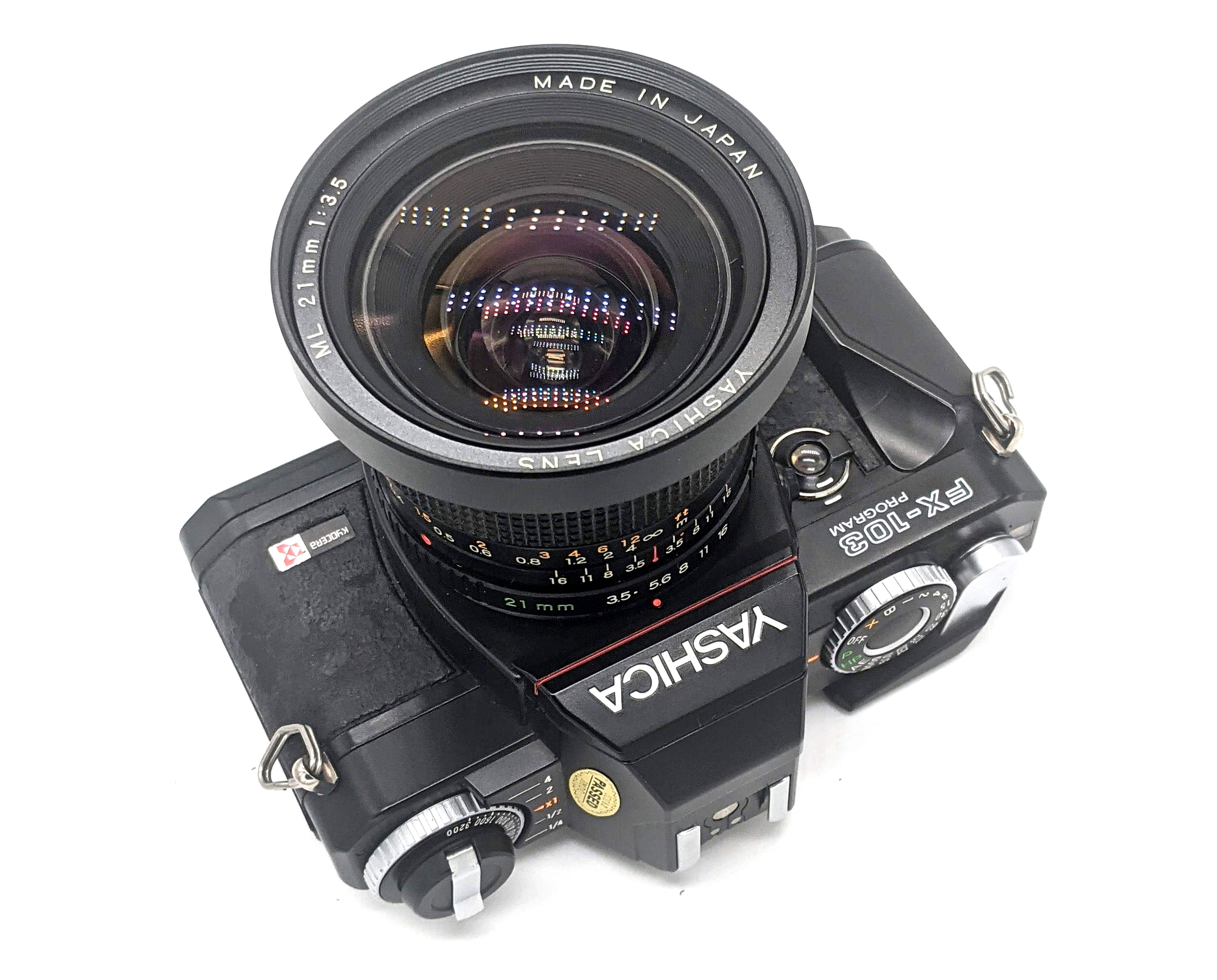
Kyocera-owned Yashica of Japan manufactured four program-mode, electronic-shutter, manual-focus C/Y-mount SLRs: the FX-103, 107, 108, and 109. The FX-103 was introduced during early 1985 shortly after the unveiling of the impressive Contax 159MM. At launch, retailers offered the 159MM for about $425 with a 50mm f/1.7 Contax Zeiss lens while the FX-103 was usually priced around $250 with a 50mm f/1.9 ML Yashica lens. However, camera stores often bundled the FX-103 in all sorts of configurations, with flashes, zooms, winders, and even sometimes with the Contax 50mm f/1.7.
The FX-103’s claims to fame include the fact that: (1) it was the first Yashica body that could offer three different exposure modes: program (high and regular), aperture priority, and manual; (2) it was the last Yashica manual-focus SLR that included the shutter speed information in the viewfinder; and (3) it had the best viewfinder of all Yashica bodies. However, there was one feature that the program-mode Yashicas had that no Contax camera featured: the ability to use “Program Mode” with every single lens made in the C/Y mount. On the other hand, Contax bodies could only use post-1985 “MM” lenses in their program modes because of the way those lenses interact with the bodies’ electronics.
In terms of design, the FX-103 is direct descendant of, and shares much in common with the prior 1980 FX-D and the de-featured 1983 FX-70. The FX-103 also shares the same basic viewfinder as the Contax 137 MD/MA, the Contax 139Q, and the FX-D. The primary differences between the FX-103 and the FX-D are the the FX-103’s addition of program modes, its capability for TTL flash, its much brighter focusing screen, and the FX-D’s exposure-lock capability via a switch on the front of the camera.
Although the most “functional” 35mm Yashica camera body made up to that time, the FX-103 is really nothing special when compared with the 1985 offerings of other major manufacturers like Canon, Nikon, and Minolta. During that year, the latter companies were marketing products like the T80, the N2000, and the autofocus Maxxum 7000.
It goes without saying that the best “backup” body for your Contax is another Contax. However, if, despite all of that, you are still in the market for a Yashica film camera body, should you consider the FX-103 over models like the FX-3 Super 2000 or the FX-D? Let’s take a closer look.
Specifications
| Year Introduced | 1985 |
| Weight | 460g |
| Battery | 2 x LR44 |
| Shutter Speeds | B, 16 sec – 1/1000 |
| Viewfinder | 95% / 0.86x |
| TTL Flash? | Yes (Dedicated Units) |
| Flash Sync | 1/100 |
| Focusing Screen | Fixed Microprism / Split |
| ASA Range | 12-3200 |
| Motor Drive? | External |
| Auto Exposure Modes | Program (Regular & High) / Aperture / Manual |
| DOF Preview? | No |
| Settings In VF | Shutter Speed |
| Exposure Lock? | No |
| Exposure Compensation? | +2 to -2 |

Operation
While the FX-103 is significantly de-featured compared with the contemporary Contax 159MM, apart from the lower top shutter speed, it has fairly similar real-world functionality. The FX-103 is an odd mishmash of features on prior Contax/Yashica products: (1) the viewfinder of the 137/139 without the aperture information; (2) the basic body frame of the FX-D; and (3) the winder contacts of the 139/FX-D; and (4) the self-timer switch of the 139/159MM. The FX-103 is a remarkably small and light body. Here are some of the highlights and lowlights of its functionality.
Shutter: The FX-103’s top shutter speed is only 1/1000. This is a bit below par for the mid-1980s when most decent electronic-shutter SLRs could hit 1/2000 and even 1/4000. The shutter is quite pronounced and clanky because of an unusual lack of effective mirror dampening. The shutter sound is perhaps my least favorite aspect of this camera.
Viewfinder: The viewfinder is one of the best aspects of this camera. The FX-103’s viewfinder has a good 95% coverage and an average 0.86x magnification. The focusing screen is much brighter than the one in the FX-D and similar to that found on the 139/137. On the right side of the viewfinder is displayed the shutter speed range. Red LED lights illuminate to the right of each speed. There is a green “P” at the top to remind you whether the lens is set in the right position for program mode. Unfortunately, Yashica omitted the capability from the 137/139 to show the aperture setting in the viewfinder. The non-interchangeable screen is the standard split-screen microprism type.
Exposure Modes: A large improvement over the FX-D was the addition of two program modes: “regular” and “high.” As noted above, program modes will work with all C/Y lenses, unlike Contax’s limitation to “MM” lenses. All that is necessary is to set whatever lens attached to its minimum aperture setting. High program mode, in theory, is for longer lenses to ensure that the shutter speed remains high enough to prevent “camera shake.” However, the FX-103’s programming is not super aggressive in this regard, with only two (sometimes only one) shutter speeds between regular and high. The program mode has no shutter speed “floor.” In other words, the camera will set the shutter speed as low as necessary for correct exposure. The FX-103 also retains straightforward aperture-priority operation. A metered manual mode is also available by matching the LEDs in the viewfinder through the adjustment of the shutter speed and aperture.
Lack of Exposure Lock: In the only feature deleted from the FX-D, the FX-103 does not have the capability for exposure lock, lacking the front-mounted switch of the 139, FX-D, and RTS II. The FX-103 has a front-mounted switch, but it is only for a self-timer and a battery check light.
Cable Release: The FX-103 does not have a standard mechanical cable release slot. Instead, there is something called the “Cable Switch S” that will attach to a socket on the back side of the camera. This is the same cable that Contaxes use.
External Winder: There are two winders that will work with the FX-103. The first is the “Contax Winder II” designed for the 139, which has a modest 2 frames-per-second max speed and a nifty auxiliary shutter release. The second is the “Yashica FX Winder” which is basically the same unit but lacks the second shutter release. As you know, these older winders neither assist in loading or rewinding the film. These winders seems to have zero sound dampening and are quite loud.
TTL Flash: Another big improvement over the FX-D was the addition of TTL flash when using the then-new Yashica CS-203 flash as well any Contax TLA-series flash. A compatible flash will automatically change the camera’s shutter speed to 1/100.
Accessories: The FX-103 uses the standard eyecup (either the rectangular or circular one) that works on nearly all Yashica and Contax bodies. Yashica also produced a useless data back that was capable of imprinting the date directly onto the negative.
Compared
Here are the 159MM, the FX-103, and the FX-3 Super 2000 compared. As we can see, the FX-103 has several significant advantages over the FX-3 Super 2000: (1) a better viewfinder; (2) TTL flash; (3) real exposure information in the viewfinder; (4) the capability to use an motor drive; and (5) a dedicated exposure compensation dial. Of course, the FX-3 Super 2000 has a slightly higher top shutter speed.
| Contax 159MM | Yashica FX-103 | Yashica FX-3 2000 | |
| Year Introduced | 1985 | 1985 | 1986 |
| Weight | 520g | 460g | 445g |
| Battery | 2 x SR44 | 2 x SR44 | 2 x SR44 |
| Shutter Speeds | B, 60 sec – 1/4000 | B, 16 sec – 1/1000 | B, 1 – 1/2000 |
| Viewfinder | 95% / 0.82x | 95% / 0.86x | 92% / 0.91x |
| TTL Flash? | Yes (Dedicated Units) | Yes (Dedicated Units) | No |
| Flash Sync | 1/100 (Dedicated); 1/250 (Auto) | 1/100 | 1/125 |
| Focusing Screen | Interchangeable Microprism / Split | Fixed Microprism / Split | Fixed Microprism / Split |
| ASA Range | 12-3200 | 12-3200 | 25-3200 |
| Motor Drive? | External | External | No |
| Auto Exposure Modes | Program (3) / Aperture | Program (2) / Aperture | Metered Manual |
| DOF Preview? | Yes | No | No |
| Settings In VF | Shutter Speed / Aperture | Shutter Speed | 3 x LEDs |
| Exposure Lock? | Yes | No | No |
| Exposure Compensation? | +2 to -2 | +2 to -2 | No |

Repairs
Like any nearly 40 year-old camera, many FX-103s you may run across will most likely require a full replacement of the light seals and mirror dampener prior to serious usage. Furthermore, like many other Kyocera-produced Contaxes and Yashicas, the FX series are susceptible to “mirror slip” issue, a phenomenon where the glued-on reflex mirror starts to slip from its housing. In extreme cases, it will slip so far that the mirror may hit the back of a lens. As with any electronic cameras, there is also always a small risk that the electronics have failed over the years.

Conclusions
Kyocera was careful to ensure that no Yashica body could truly compete on features with a contemporary or prior Contax body. The FX-103 could have been a kind of “program mode” version of the Contax 139, but Kyocera decided not to do that. Although conventional thinking about Yashica C/Y bodies has traditionally focused upon the FX-3, the FX-103 is arguably a more versatile and advanced platform and has a brighter focusing screen than either. Its main achilles heel is the lack of an exposure lock. If looking for the most “advanced” Yashica SLR, that would probably be the 109 MP, which does have the 1/2000 top speed and auto film load/advance/rewind, but its lack of exposure feedback renders it yet another imperfect, “almost there” Yashica product.